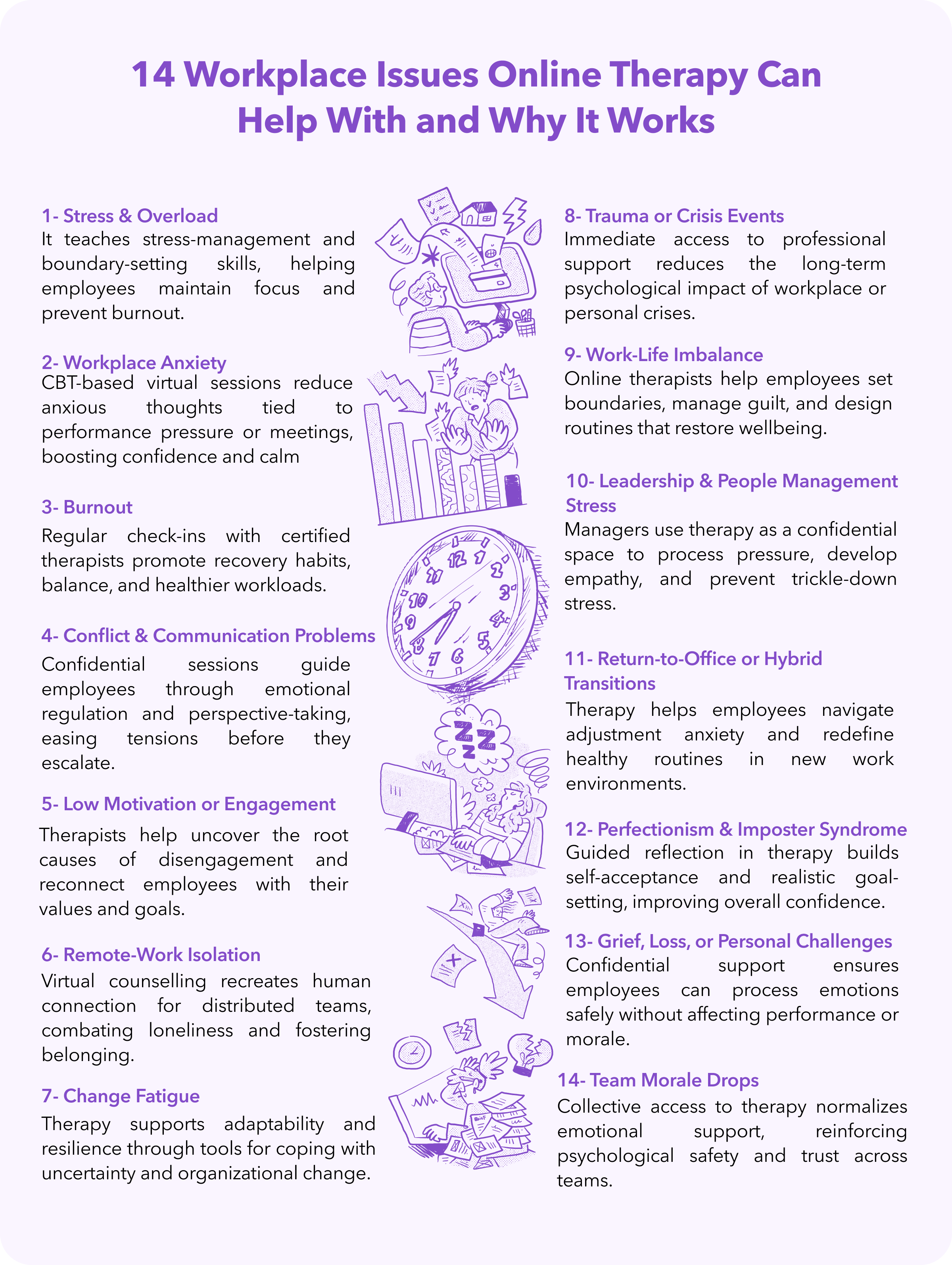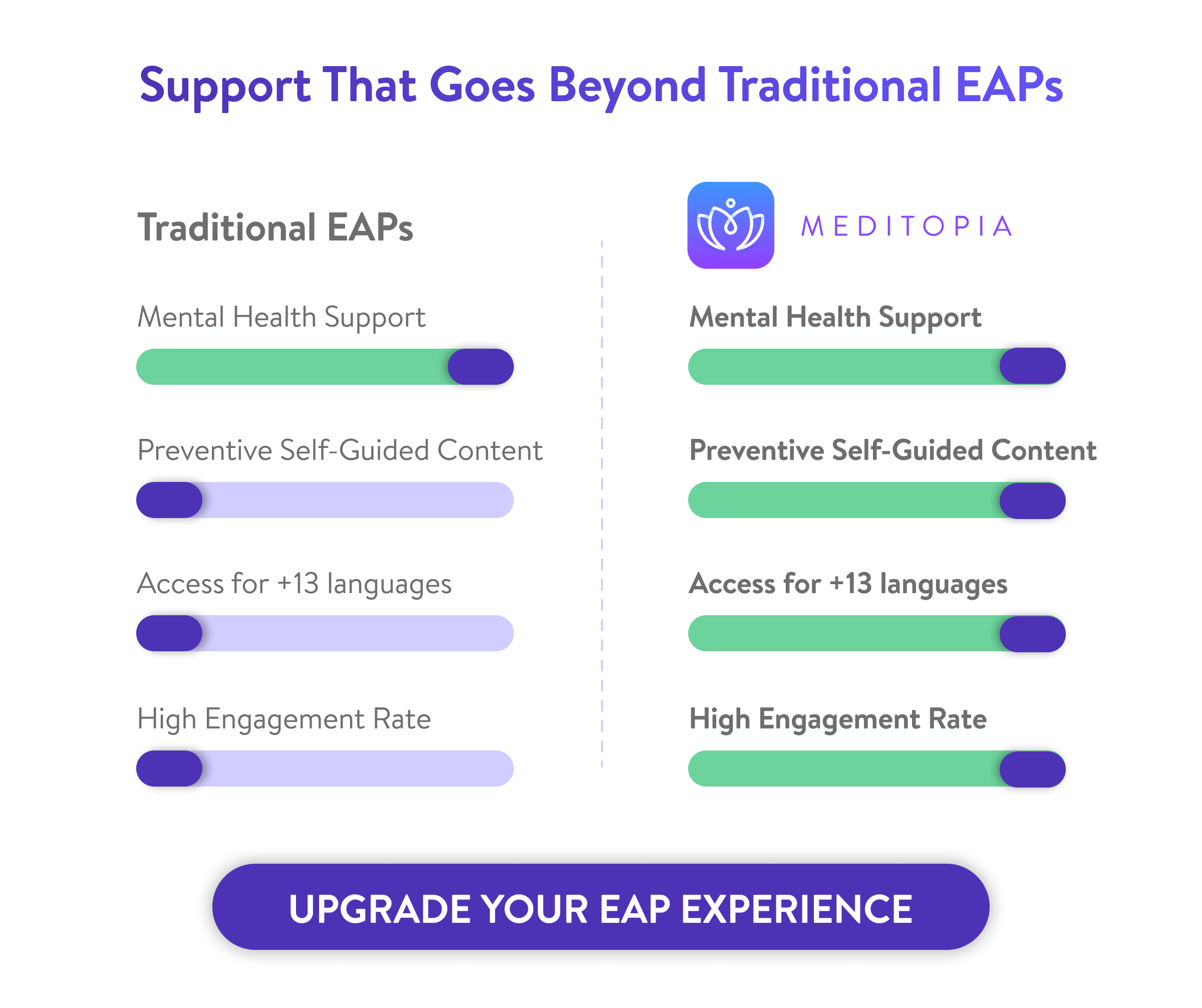With hybrid teams, constant change, and rising burnout levels, the old ways of offering support simply can’t keep up. What companies need today is accessible, flexible, and scalable psychological care that meets people where they are. Let's check how online therapy for employees is beneficial for your organizational goals, and how to use it to it's maximum potential.
Why Online Therapy is Critical in the Modern Workplace
When I was studying Psychology (15 years ago), many teachers were against online therapy. Their main claim was "it blocked the rapport generation." What they were not considering was that the online therapeutic context generated its own type of rapport. Especially among millennials. These days, online counselling is common, and proven to be beneficial across all contexts. In the corporate one, here's why online therapy for employees is particularly useful:
- Greater accessibility and flexibility:
Online therapy removes geographic and time constraints. Employees across locations can access therapy from anywhere, at times that fit their schedules. This inclusivity makes it a key pillar of your employee wellness resources. - Faster access to care, reducing delay barriers:
Traditional therapy can have waits of weeks; by contrast, digital platforms often enable first sessions within 24–48 hours or less, helping employees get support before issues escalate. - Improved engagement due to privacy and reduced stigma:
Many workers avoid in-person therapy out of fear of judgment or exposure. Virtual sessions allow confidential counselling via personal devices, increasing uptake.- In fact, only about 13% of employees feel comfortable discussing mental health in the workplace under traditional settings [1].
- Tangible clinical and productivity benefits:
Studies confirm significant reductions in depression and anxiety symptoms, and the intervention produced a positive financial return on investment across all salary levels [2].- Moreover, for every $1 invested in treatment for common mental health disorders, companies get approximately $4 back through improved productivity and lower absenteeism [3].
- Sustained ROI over time:
Once mature, these initiatives yield a median ROI of CA$2.18 per dollar invested (versus CA$1.62 in earlier years), showing that longer-term deployment and integration drive stronger returns [4]. - Reduced disability and absence claims:
Mental health issues account for 30–40% of short-term disability claims and about 30% of long-term disability claims in some datasets, highlighting how psychological strain drives substantial costs.
Common Workplace Mental Health Challenges Online Therapy Addresses
The modern workplace brings diverse emotional demands. Here’s how therapy for employees help address them:
- High workload & anxiety → Cognitive Behavioral Therapy (CBT) and mindfulness sessions improve focus and calm under pressure.
- Remote isolation & burnout → Scheduled counselling fosters connection and mitigates fatigue.
- Workplace conflict & stress → Confidential mediation and talk therapy restore psychological safety.
- Trauma or crisis → Fast access to certified therapists prevents long-term absenteeism.
- Lack of work-life balance → Structured digital programs support boundaries and recovery.
When organizations invest in corporate wellness resources, these benefits translate into tangible outcomes: better retention, higher morale, and fewer sick leaves.

Traditional Therapy vs. Online Therapy for Employees
While traditional therapy remains valuable, digital transformation has reshaped how organizations deliver support. Here’s how the two compare in today’s work landscape:
Leading Online Therapy Platforms for Companies
Today’s best wellbeing resources for companies combine clinical support with digital innovation. Here are a few global leaders redefining how therapy meets modern work culture:
- Meditopia for Work:
- Offers 1:1 expert sessions, AI-powered mental health coaching, and over 10,000 preventive wellness tools and resources in 14 languages.
- Scientifically proven to reduce stress levels by up to 20% and boost positive emotions by 40% in only 8 weeks.
- Integrates seamlessly with HR systems and Employee Assistance Programs (EAPs).

- Unmind:
- A holistic corporate wellness resource focusing on proactive mental fitness and leadership training.
- Offers customizable dashboards for tracking engagement and wellbeing metrics.
- Spill Chat:
- Slack-integrated virtual therapy for employees providing quick, confidential sessions with licensed professionals.
- Great fit for startups and digital-first organizations.
- Oliva:
- Combines therapy, coaching, and group sessions under one digital umbrella.
- Certified therapists and personalized pathways improve long-term resilience.
Each of these platforms represents a new generation of holistic wellness business resources, blending human care with technology to scale wellbeing globally.
How to Introduce Online Therapy to Your Workforce
Rolling out an organizational therapy initiative requires thoughtful planning. Here’s how HR and leadership teams can make the process smooth and effective:
- Assess current needs: Conduct anonymous surveys or wellbeing assessments to identify stressors and preferences.
- Choose the right platform: Look for multilingual, compliant, and AI-powered tools for employee wellbeing that align with your company culture.
- Communicate openly: Normalize therapy by emphasizing confidentiality and inclusivity in all internal communications.
- Train managers: Equip leaders with HR wellbeing tools to recognize signs of stress and guide employees toward support.
- Integrate gradually: Combine therapy access with other community wellbeing tools and wellbeing initiatives for holistic impact.
Meditopia for Work takes care of these implementations for you. Our employee wellbeing tools can redefine the culture of care in your organization, contact us to provide you with a full free demo.
Measuring ROI and Engagement from Online Therapy
For decision-makers, the success of employee wellness resources must be measurable. The most effective organizations track the following indicators:
- Utilization rate: Percentage of employees engaging with therapy services.
- Absenteeism reduction: Drop in sick days related to stress or burnout.
- Employee satisfaction: Post-session feedback and wellbeing pulse surveys.
- Retention and engagement: Correlation between therapy access and turnover rates.
- Productivity improvement: HR analytics reflecting performance stability after interventions.
Meditopia for Work measures its impact on your organization and provides preventive measures.













.jpg)










